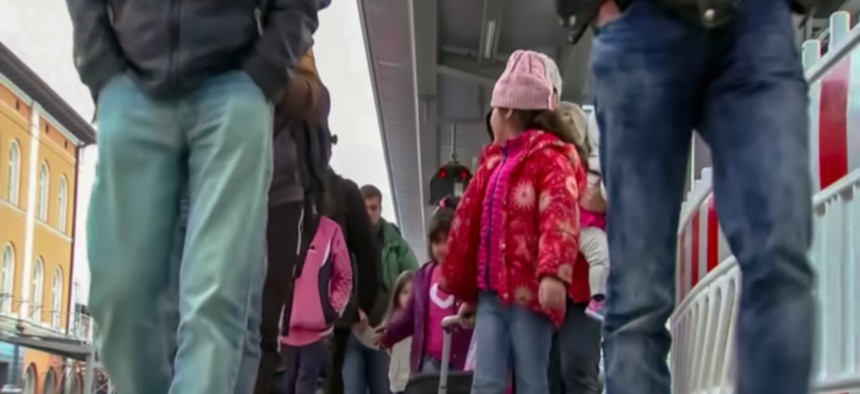When Government Does Not Work: A Primer
A new book chronicles the Trump administration’s efforts to upend the U.S. immigration system.
Alternative titles for the recent book by Julie Hirschfeld Davis and Michael D. Shear, both Washington correspondents for the New York Times, could have been Border Mess or Border Chaos. The book, Border Wars: Inside Trump’s Assault on Immigration presents a distressing picture of Washington at work (or not at work), both on the frontline of these particular “wars” and in policy making. As a case study in mismanagement, Border Wars reminds one of The Great Deluge: Hurricane Katrina, New Orleans, and the Mississippi Gulf Coast, in which Douglas Brinkley describes government’s failure to respond effectively to that crisis. Unlike Hurricane Katrina, however, problems related to border management and immigration are ongoing.
Border Wars is indeed a disturbing book to read. It describes three significant failures of government:
Policy Failures
The primary culprits in policy-making failures are both houses of Congress and the White House. Davis and Shear describe numerous failed attempts to come to any agreement on the Deferred Action for Childhood Arrivals bill, which aims to address the status of individuals who were brought to the United States as children and, in many cases, have no experience of their nation of origin, as well as other immigration legislation. The title of Norm Ornstein and Tom Mann’s 2012 classic book, It’s Even Worse Than It Looks, is still applicable today. There are no heroes who artfully architect policy compromises in Border Wars.
Administrative Failures
The book devotes several chapters to describing the child separation crisis on the border. The challenge of reuniting children separated from their parents proved much more difficult than anticipated by any of the federal agencies involved. Alex Azar, Secretary of Health and Human Services, told his staff that it shouldn’t be that hard to reunite families. Davis and Shear report that Azar said, “We have databases to keep on top of such things.” But it turned out that was not the case. The HHS computer system contained almost no information about a child’s parents.
Davis and Shear report, “Customs and Border Protection gave HHS one number; Immigration and Customs Enforcement gave them another; DHS headquarters offered a third . . . Over several weeks, Azar and his team were given 60 different sets of data, each contradicting the others.”
The book documents the difficulty agencies have cooperating in shared mission areas. Seventeen years after creation of the Homeland Security Department, it seems that putting related agencies under one roof has not made it easier for them to work together.
Process Failures
As a long-time proponent of “speeding up” government and streamlining government processes, Border Wars makes a strong case for the need to get things right before implementing new rules. In developing new regulations imposing limits on public benefits for immigrants (the public charge rule), Davis and Shear report that the 250-page draft regulations were delivered to top officials at Citizenship and Immigration Services with “the urgent message that comments should be provided by the next morning at 8 a.m.” As with the infamous Muslim ban, the proposed regulations, once issued, quickly spawned lawsuits, and now the courts will be left to sort it out.
The book contains several interesting stories of civil servants who followed the processes that they had spent their careers respecting. Larry Bartlett, a veteran career official who oversaw refugee admissions at the State Department, defended a State Department report that showed refugees made positive economic contributions to the nation. Bartlett was removed from his position in the Bureau of Population, Refugees, and Migration and moved to the Freedom of Information Act office. Eventually, with little fanfare, he reclaimed his previous position. Davis and Shear write, “The inspector general was still looking into allegations that he and others had been targeted for political retaliation.”
In Homeland Security’s Office for Civil Rights and Civil Liberties, Scott Shuchart and his colleagues began to hear stories about a pilot program in El Paso to separate children. Shuchart sent a “stinging, six-page memo” that predicted “family separation and ‘zero tolerance’ prosecution of border crossers” would lead to a “chaotic crisis.” Not surprising to anyone who followed this issue, “The plea fell on deaf ears,” according to the authors.
There are no management recommendations or policy proposals in Border Wars. Davis and Shear are journalists focused on documenting history. But there are clearly lessons to be learned from the book. All new administrations enter office with a long list of policy goals on which they campaigned. Most administrations (both Democratic and Republican) discover that success in implementing those policy proposals is largely dependent on their ability to understand the bureaucracy they now run. Their ability to successfully translate policy proposals into clear “implementable” (and legal) actions that agencies can undertake is key. Border Wars illustrates the adage that haste makes waste when trying to implement new policies. There are few shortcuts in government. Future administrations, pay heed.
Mark A. Abramson is president of Leadership Inc. His most recent book is Government for the Future: Reflection and Vision for Tomorrow’s Leaders (with Daniel J. Chenok and John M. Kamensky). His email address is mark.abramson@comcast.net.



